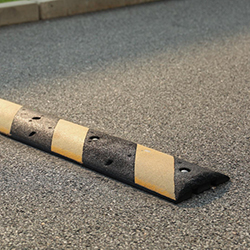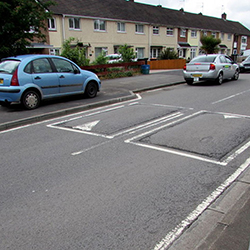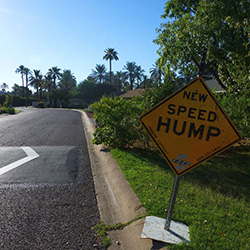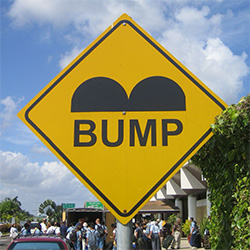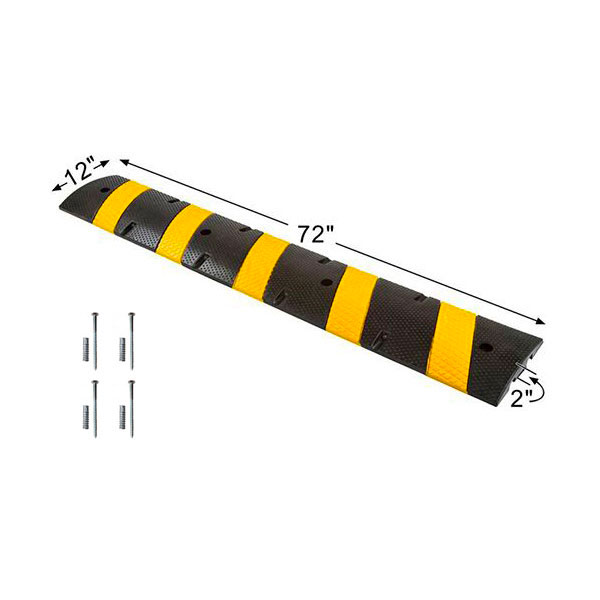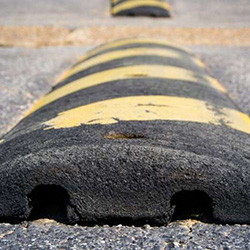Category Archives: Speed Bumps
Exploring Speed Humps: Design and Functionality
The Design Features of Speed Humps
Speed humps are engineered with a more gradual slope than speed bumps, allowing for a smoother transition for vehicles. Their elongated design is intended to reduce vehicle speeds over a longer distance without causing significant discomfort to drivers or passengers. Continue reading “Exploring Speed Humps: Design and Functionality” »Maximize Safety and Aesthetics
Unveiling the Durability of Our Premium Speed Bump
The Impact of Speed Bumps and Humps
The Life-Saving Benefits of Speed Humps and Speed Bumps
Rubber parking stops for garage
Enhancing Garage Safety and Organization with Rubber Parking Stops
Introduction: Garages are not just spaces to park vehicles; they also serve as storage areas and workshops. As such, maintaining order and safety within the confines of a garage is essential. One often overlooked but highly effective solution for enhancing garage safety and organization is the use of rubber parking stops. These simple yet durable devices offer numerous benefits that can transform a cluttered and hazardous garage into a well-organized and secure space.- Preventing Accidents and Damage: Rubber parking stops act as physical barriers, preventing vehicles from accidentally rolling too far and causing damage to walls, equipment, or other vehicles. These stops create a designated parking area, reducing the risk of accidental collisions within the garage.
- Guiding Proper Parking: Installing rubber parking stops helps guide vehicles into their designated parking spots. This is particularly useful in shared or multi-vehicle garages where clear demarcation is essential to ensure each vehicle has its own space. It also aids in optimizing the available space efficiently.
- Easy Installation: Rubber parking stops are easy to install, making them a convenient solution for homeowners and businesses alike. They can be permanently secured to the garage floor using anchors or temporarily placed for flexibility. This ease of installation means that anyone, regardless of their handyman skills, can benefit from this safety measure.
- Durability and Weather Resistance: These stops are typically made of durable rubber, which is resistant to weather conditions, chemicals, and UV rays. This makes them suitable for both indoor and outdoor garage use. The longevity of rubber parking stops ensures a lasting investment in garage safety and organization.
- Versatility: Rubber parking stops are versatile and can be used for various purposes beyond guiding vehicles. They can serve as markers for storage areas, workstations, or designated zones for specific activities. Their adaptability makes them a valuable addition to any garage space.
- Cost-Effective Solution: Compared to potential repair costs resulting from vehicle collisions or other accidents in the garage, rubber parking stops are a cost-effective preventive measure. The initial investment in these stops can save money in the long run by avoiding damage to vehicles and property.
- Environmentally Friendly: Rubber parking stops are often made from recycled materials, contributing to environmentally friendly practices. Choosing eco-friendly options for garage accessories aligns with a sustainable lifestyle, making these stops an excellent choice for conscientious homeowners.
Recycled Rubber Speed Bumps: Sustainable Solutions for Traffic Control
Why Choose Recycled Rubber Speed Bumps?
First and foremost, using recycled rubber speed bumps is a win for the environment. By repurposing old tires, we can reduce waste and pollution while also providing a sustainable traffic control option. But the benefits don’t stop there. These speed bumps are also extremely durable and effective, able to withstand heavy traffic and varying weather conditions. Not to mention, they are also cost-effective compared to traditional materials. These factors make recycled rubber speed bumps an ideal choice for many communities.Why Choose Recycled Rubber Speed Bumps?
When it comes to traffic control, there is a growing concern for the environmental impact of traditional methods. That’s why more and more communities are turning to sustainable solutions, such as recycled rubber speed bumps. Not only do these speed bumps provide effective traffic control, but they also offer numerous environmental benefits. Made from old tires, recycled rubber speed bumps help reduce waste and pollution. Plus, they are extremely durable and cost-effective compared to traditional materials. Many locations have already successfully implemented recycled rubber speed bumps, proving their effectiveness in promoting sustainability. But it’s not just about traffic control – the larger impact of using these speed bumps can also lead to other industries adopting similar practices. And with potential government incentives, it’s a win-win for both the environment and our communities.The Science Behind Recycled Rubber Speed Bumps
Creating sustainable solutions for traffic control involves not only using recycled materials, but also understanding the science behind its effectiveness. Recycled rubber speed bumps are made by repurposing old tires, reducing waste and pollution. The engineering behind the design ensures optimal traffic control, while meeting safety standards. The use of recycled rubber also makes these speed bumps durable and long-lasting, reducing the need for frequent replacements. In addition, noise reduction solutions have been incorporated into the design to address potential concerns. Ongoing research and development in this area continue to improve the effectiveness and versatility of recycled rubber speed bumps. By understanding the science behind these speed bumps, we can see the true value of using them as a sustainable solution for traffic control.Promoting Sustainable Practices in Traffic Control
Using recycled rubber speed bumps for traffic control not only offers environmental benefits, but it also promotes sustainable practices. These speed bumps are made from old tires, reducing waste and pollution. By implementing them, we are taking a step towards a more sustainable future. This practice can also inspire other industries to adopt similar methods, further reducing our impact on the environment. In addition, governments can offer incentives to encourage the use of sustainable traffic control methods, promoting a more eco-friendly approach. It is important to consider the environmental impact of traditional traffic control methods, which contribute to pollution and waste. By choosing recycled rubber speed bumps, we can make a positive impact on the environment and promote sustainable practices in traffic control.The Versatility of Recycled Rubber Speed Bumps
Recycled rubber speed bumps are not only a sustainable solution for traffic control, but they are also highly versatile. With different types of recycled rubber speed bumps available, they can be easily installed on various road surfaces and areas such as parking lots and school zones. The flexibility in installation options allows for efficient use in different settings, making them a practical choice for traffic management. Additionally, the color and design of recycled rubber speed bumps can be customized to blend seamlessly with the surrounding environment. Moreover, the durability of these speed bumps makes them suitable for heavy traffic areas, ensuring long-term effectiveness. The versatility of recycled rubber speed bumps also extends to their noise reduction capabilities, making them a preferred choice in residential areas. Overall, the versatility of recycled rubber speed bumps makes them a top choice for traffic control solutions. With their numerous benefits and adaptability, they can be utilized in a variety of settings, making them a sustainable and effective option for promoting smoother and safer traffic flow.Challenges and Solutions
Despite the numerous benefits of using recycled rubber speed bumps for traffic control, there may be some challenges or criticisms that arise. One potential challenge is the durability of the material, as some may question its ability to withstand heavy traffic over time. However, this has been addressed through the use of high-quality materials and advanced engineering techniques. Another concern may be the noise level produced by vehicles passing over the speed bumps. In response, many manufacturers have implemented noise reduction measures, such as adding ridges or grooves to the surface of the bumps. Additionally, ongoing research and development in this area are constantly improving the design and functionality of recycled rubber speed bumps. With these solutions in place, any potential challenges can be effectively managed, making recycled rubber speed bumps a sustainable and highly effective solution for traffic control.Conclusion
In conclusion, it is evident that recycled rubber speed bumps are a sustainable and effective solution for traffic control. They not only provide environmental benefits by reducing waste and pollution, but also offer durability and cost-effectiveness. Moreover, their versatility allows for customization and flexibility in installation. By choosing recycled rubber speed bumps, we can promote sustainable practices not only in traffic control but also in other industries. Governments can also play a crucial role by providing incentives for the widespread implementation of these speed bumps. As we continue to research and develop new solutions, the challenges and criticisms of using recycled rubber speed bumps are being addressed. It is time to prioritize sustainability in traffic control and consider using recycled rubber speed bumps as a viable option. Let’s take a step towards a greener and more sustainable future.The Importance of Speed Bumps in School Zones
Overview
Introduction
In recent years, there has been growing concern about the safety of children in school zones. With the increase in traffic and the fast-paced nature of today’s society, it has become crucial to implement measures that ensure the well-being of students. One such measure that has gained significant attention is the installation of speed bumps in school zones. These physical traffic calming devices are designed to slow down vehicles and create a safer environment for pedestrians, particularly children. This article explores the importance of speed bumps in school zones and highlights their role in promoting road safety and protecting the lives of young students.
Purpose of the article
The purpose of this article is to highlight the importance of speed bumps in school zones. With the safety of children being a top priority, speed bumps serve as an effective traffic calming measure to reduce the speed of vehicles passing through these areas. By slowing down the traffic, speed bumps help create a safer environment for students, teachers, and other pedestrians. This article aims to raise awareness about the significance of speed bumps in ensuring the well-being and protection of everyone in school zones.
Importance of speed bumps in school zones
Speed bumps play a crucial role in ensuring the safety of children in school zones. By slowing down the speed of vehicles, speed bumps help reduce the risk of accidents and injuries. They serve as a visual reminder for drivers to be cautious and alert, especially in areas where children are present. The presence of speed bumps also encourages drivers to adhere to the designated speed limits, creating a safer environment for everyone. Additionally, speed bumps promote a sense of community awareness and responsibility, as they signify the importance of prioritizing the well-being of young students. Overall, the installation of speed bumps in school zones is vital in protecting the lives of children and maintaining a secure educational environment.
Benefits of Speed Bumps
Reducing vehicle speed
Reducing vehicle speed is crucial in school zones to ensure the safety of children. Speed bumps play a significant role in achieving this objective. By strategically placing speed bumps along the roads within school zones, drivers are forced to slow down and adhere to the designated speed limits. This helps to minimize the risk of accidents and provides a safer environment for students to cross the road or walk to school. Speed bumps serve as a visual reminder for drivers to exercise caution and be mindful of their speed, ultimately contributing to the overall safety of the school community.
Enhancing pedestrian safety
Speed bumps play a crucial role in enhancing pedestrian safety in school zones. By slowing down vehicles, speed bumps force drivers to reduce their speed, providing a safer environment for students and other pedestrians. These traffic calming measures serve as a visual reminder for drivers to exercise caution and be aware of their surroundings. Additionally, speed bumps encourage drivers to be more attentive, reducing the risk of accidents and potential injuries. Overall, the presence of speed bumps in school zones contributes to the overall goal of prioritizing the safety and well-being of pedestrians, especially young students.
Preventing accidents
Speed bumps play a crucial role in preventing accidents in school zones. By slowing down the vehicles passing through these areas, speed bumps force drivers to be more cautious and attentive. This helps to reduce the risk of collisions and ensures the safety of students and pedestrians. Additionally, speed bumps serve as a visual reminder for drivers to adhere to the designated speed limits, promoting a culture of responsible driving. Overall, the presence of speed bumps in school zones is essential for creating a safe and secure environment for everyone.
Design and Placement of Speed Bumps
Proper dimensions and materials
When it comes to speed bumps in school zones, proper dimensions and materials are crucial. The dimensions of speed bumps should be designed in such a way that they effectively slow down vehicles without causing any discomfort or damage. They should be wide enough to cover the entire width of the road, ensuring that drivers are compelled to slow down. Additionally, the height of the speed bumps should be appropriate to ensure that vehicles reduce their speed significantly. In terms of materials, speed bumps should be made of durable and non-slip materials to withstand heavy traffic and adverse weather conditions. This ensures their longevity and effectiveness in ensuring the safety of students and pedestrians in school zones.
Strategic placement
Strategic placement of speed bumps in school zones is essential for ensuring the safety of students and pedestrians. By strategically placing speed bumps at key locations within the school zone, such as near crosswalks and entrances, drivers are forced to slow down and be more cautious. This helps to prevent accidents and encourages a safer environment for everyone. Additionally, the strategic placement of speed bumps can also serve as a visual reminder for drivers to be aware of their surroundings and to prioritize the safety of those around them. Overall, the strategic placement of speed bumps plays a crucial role in promoting the well-being of students and creating a secure school zone.
Consideration of traffic flow
When considering the implementation of speed bumps in school zones, it is crucial to take into account the impact on traffic flow. While the safety of students is of utmost importance, it is essential to find a balance that minimizes disruptions to the overall traffic movement. By carefully analyzing the traffic patterns and consulting with traffic experts, it is possible to design speed bumps that effectively slow down vehicles without causing significant congestion or delays. This consideration of traffic flow ensures that the implementation of speed bumps in school zones is both beneficial for student safety and efficient for the surrounding community.
Effectiveness of Speed Bumps
Studies and research
Studies and research have consistently shown the significant impact of speed bumps in school zones. These traffic calming devices play a crucial role in ensuring the safety of students, teachers, and other pedestrians in and around educational institutions. Numerous studies have demonstrated that the presence of speed bumps effectively reduces vehicle speeds, thereby minimizing the risk of accidents and injuries. Additionally, research has also indicated that speed bumps contribute to improved traffic flow and encourage drivers to be more cautious and attentive while driving through school zones. The implementation of speed bumps in these areas has proven to be an effective measure in promoting a safer environment for everyone involved.
Real-world examples
Real-world examples of the importance of speed bumps in school zones can be found in various cities across the country. For instance, in City X, the installation of speed bumps near schools has significantly reduced the number of accidents involving children. The presence of speed bumps serves as a visual reminder for drivers to slow down and be cautious in these areas. Similarly, in City Y, the introduction of speed bumps has improved pedestrian safety by deterring speeding and encouraging drivers to be more aware of their surroundings. These real-life instances highlight the effectiveness of speed bumps in ensuring the safety of students and pedestrians in school zones.
Positive impact on school zones
Speed bumps in school zones have a positive impact on ensuring the safety of students. By slowing down the traffic, speed bumps help to prevent accidents and create a safer environment for children to walk or bike to school. They also serve as a visual reminder for drivers to be cautious and watch out for children crossing the road. Additionally, speed bumps encourage drivers to adhere to the designated speed limit, reducing the risk of speeding and reckless driving in school zones. Overall, the presence of speed bumps in school zones plays a crucial role in protecting the well-being of students and promoting a secure learning environment.
Challenges and Concerns
Potential damage to vehicles
Potential damage to vehicles is a significant concern when it comes to the installation of speed bumps in school zones. These traffic calming measures are designed to slow down vehicles and promote safety, but they can also pose a risk to the vehicles themselves. The abrupt changes in speed and the height of the speed bumps can cause damage to the suspension, tires, and other components of vehicles. It is important for drivers to approach speed bumps with caution and reduce their speed to minimize the risk of damage. Additionally, regular maintenance and inspection of speed bumps are necessary to ensure they are in good condition and do not pose a threat to vehicles passing over them.
Impact on emergency vehicles
Driveway speed bump in school zones have a significant impact on emergency vehicles. While these traffic calming measures are effective in reducing the speed of vehicles and ensuring the safety of children, they can also cause delays for emergency vehicles trying to reach their destinations quickly. The presence of speed bumps can slow down ambulances, fire trucks, and police cars, potentially affecting their response time during critical situations. Balancing the need for speed reduction in school zones with the importance of quick emergency response is a challenge that requires careful consideration and planning.
Driver frustration and road rage
Driver frustration and road rage are serious concerns in school zones. With the increasing number of vehicles on the road, drivers often find themselves in a rush, leading to impatience and aggressive behavior. This can be particularly dangerous in areas where children are present, as it puts their safety at risk. Speed bumps play a crucial role in addressing this issue by forcing drivers to slow down and be more cautious. By creating a physical barrier that requires drivers to reduce their speed, speed bumps help to reduce driver frustration and promote safer driving in school zones. Additionally, they serve as a visual reminder for drivers to be mindful of their surroundings and the potential presence of children. Overall, the presence of speed bumps in school zones is essential for ensuring the safety of both drivers and pedestrians.
Conclusion
Summary of key points
In summary, speed bumps play a crucial role in ensuring the safety of children in school zones. They are effective in slowing down vehicles and reducing the risk of accidents. By forcing drivers to decrease their speed, speed bumps provide a safer environment for students to cross the road and navigate the school area. Additionally, speed bumps serve as a visual reminder for drivers to be cautious and attentive in school zones. Overall, the presence of speed bumps in school zones is essential for the protection and well-being of students.
Importance of implementing speed bumps
Speed bumps play a crucial role in ensuring the safety of students in school zones. By implementing speed bumps, drivers are forced to slow down, reducing the risk of accidents and injuries. These traffic calming measures create a safer environment for children to cross the road and for parents to drop off and pick up their kids. Speed bumps also serve as a visual reminder for drivers to be cautious and mindful of their speed. Overall, the presence of speed bumps in school zones is essential for promoting the well-being and protection of students.
Call to action for safer school zones
To ensure the safety of our children in school zones, it is crucial that we take action now. By implementing speed bumps in these areas, we can effectively slow down vehicles and reduce the risk of accidents. Speed bumps serve as a visual reminder for drivers to adhere to the designated speed limits, creating a safer environment for pedestrians and students. It is essential for parents, teachers, and local authorities to come together and advocate for the installation of speed bumps in school zones. Together, we can make a significant difference in ensuring the well-being of our children and promoting safer school zones.


